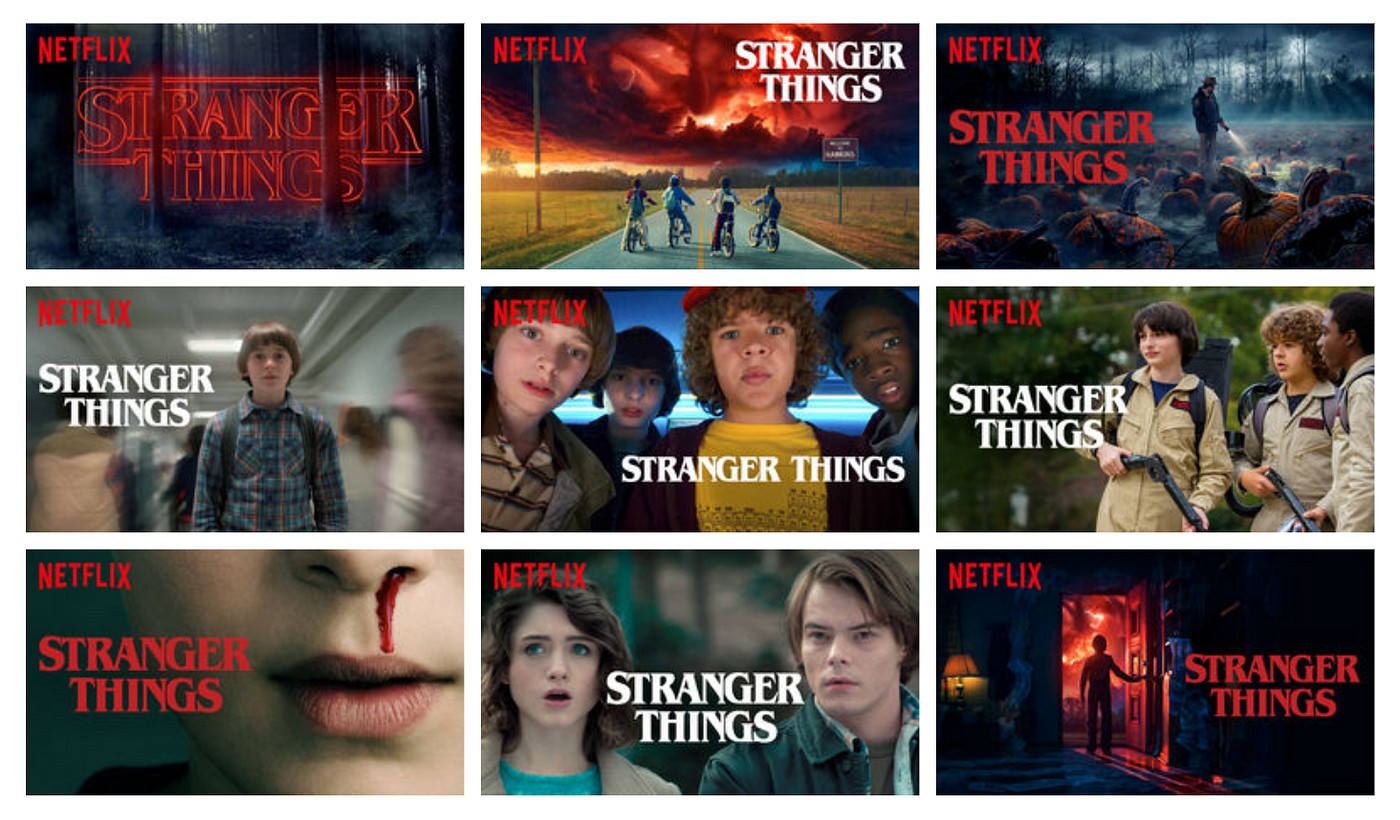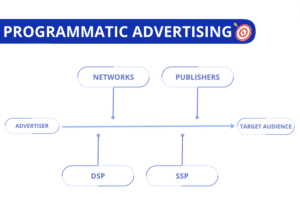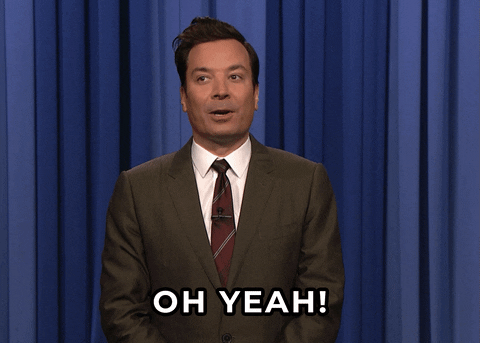Programmatic advertising is the automatic purchase of advertising space. 💲 It’s a highly effective method and, if you choose the platform and parameters carefully, it can give your business real sales and marketing impact.
What is Programmatic advertising?
Programmatic advertising definition
Programmatic advertising, widely used in the digital world, is based on a real-time bidding system. ⌚
This type of advertising uses algorithms that identify matches between data provided by companies on their target audience and advertising space provided by different media. ⚡ In other words, it’s a semi-automatic system that buys advertising space through auctions
So when a web user visits a website or uses an app, ads are auctioned on the marketplace!
Your ad will be shown to the advertiser whose profile matches your target and whose bid is the highest. 🤑
Of course, everything is automated. 🤖 Advertisers don’t actually sit down in front of their computers to “buy” this space. In fact, everything works with preconfigured parameters.
Programmatic advertising example
Netflix, the world-renowned streaming platform, is an example of a company that effectively uses programmatic ads to reach its target audience in a more precise and measurable way. 🤩 Using detailed data on user preferences and behavior, Netflix can create customized advertising campaigns highlighting new releases and original series based on the specific interests of each viewer segment. 👁️🗨️
This type of advertising allows Netflix to automatically acquire advertising space on various platforms, from websites to mobile apps to connected TV channels, maximizing the reach and effectiveness of its campaigns. 🧨 What’s more, Netflix can adjust its advertising strategy in real time based on advertising performance, increasing profit
The flexibility and efficiency of programmatic advertising help Netflix to remain agile in an ever-changing media environment and to compete in a highly competitive industry. 💪 This advertising strategy, combined with engaging, targeted content, continues to drive Netflix’s growth and expansion worldwide, making the company a dominant force in the digital entertainment industry. 🎬
Here’s a LinkedIn post, explaining how Netflix goes about targeting its users! 👈

How does programmatic marketing advertising work?
Programmatic advertising is about delivering ads quickly and efficiently to the right audience. 🗣️ It also guarantees highly precise target acquisition.
This is because behavioral and demographic data is used to deliver ads in a timely manner. 🚥 What’s more, advertisers can see exactly where their ads appear, offering greater transparency and the ability to make adjustments.
Finally, you can control costs by setting budgets and prices according to your prospecting needs. 💰
What is a programmatic advertising strategy?
An advertising strategy is a carefully crafted plan that helps companies promote their products and services to a target audience with the aim of increasing business reputation and boosting sales. 💥 Strategy involves clearly determining the objectives of your advertising campaign, such as increasing awareness, increasing engagement and increasing conversions.
It starts with thorough research to understand the needs, preferences, and behaviors of your target audience. 🥰
To achieve this, you need to: ⏬
- Identify the most appropriate advertising channels (TV, social networks, search engines, etc.) to reach this target group.
- Create effective messages and visuals (this is a critical step),
- Monitor campaign execution,
- Analyze results to continually adapt and optimize. 👌
In short, advertising strategy is an essential tool for aligning a company’s advertising efforts with its overall objectives, and assuring consistent, effective communication that resonates with consumers. 👂
How to launch programmatic advertising campaigns?
Launching programmatic campaigns requires a careful, well-coordinated approach. 🧐
Here’s a step-by-step guide to getting started: ⏬
- Define your goals: clearly determine the objectives of your campaign, such as brand awareness, user engagement or sales conversion.
- Select a platform: select the right query platform (DSP) that can automatically buy targeted ad space.
- Define your audience: use demographic and behavioral data to precisely target your audience.
- Create content: develop compelling ad creatives tailored to the different channels you want to use.
- Budget and bid: create budgets and implement bidding strategies to buy advertising space efficiently.
- Launch and monitoring: launch your campaign, monitor performance in real time, and make any necessary adjustments to optimize results.
- Analyze data at the end of the campaign to measure success and learn lessons for future efforts. 💎
By following these steps, you’ll be able to run successful programmatic campaigns! 👏

Benefits of programmatic advertising
Programmatic ads offer your business many advantages over traditional advertising. 👀
Let’s take a look at the main benefits: ⏬
1. The possibility of infinite visualizations
One of the biggest benefits of programmatic advertising is that, thanks to technology and artificial intelligence, you can deliver your ads across an infinite number of media, websites, blogs and more! 💥
It used to be difficult, even unthinkable, to reach thousands of people in a single campaign… 📣
Today, however, with just a few clicks, you really can reach millions of qualified leads with ease.
2. A specific target
“Big Data” has made it possible to collect a lot of user data. 📊 The result: a multitude of target market criteria have emerged that enable you to launch advertising campaigns aimed at audiences that correspond precisely to your future buyers.
Whereas traditional advertising offers a panel of predefined (and sometimes heterogeneous) audiences, programmatic ads helps you target only your potential customers. 🎯
There are also several audience criteria, including: 👇
- User type,
- Location
- Interests,
- Online behavior,
- Visits,
- Previous related searches.
3. Better optimization capability
Unlike traditional advertising, where costs are fixed and don’t change as traffic changes, programmatic advertising adapts to the market in real time. ⏳
Advertisers can track campaign performance and understand cost-per-click or cost-per-conversion, 🖲️ as well as the average market price.
With this information, you can quickly optimize certain ads that are performing well and drop those that aren’t. 👏
4. Improve user experience
Programmatic ads allows you to greatly personalize each ad so that users see only the ads that interest them. 🙌
This level of marketing personalization dramatically reduces online ad rejections and improves the user experience.
And, a better experience means a better chance of conversion! 🧲
5. Save time and increase efficiency
Finally, programmatic advertising is fully automated. 🦾 Thanks to the process of defining targeting and bidding criteria, the Ad Exchange platform connects various interconnected agents without any additional intervention.
Once the basic configuration is complete, you don’t have to do a thing to benefit from a large targeted audience! ⚡
This can save you a lot of time and money. 😉

Limits of programmatic advertising
Despite these pros, programmatic advertising isn’t without its challenges and limitations, which advertisers and brands need to address to get the most out of this strategy. 🙈
The biggest limitations associated with programmatic ads are: ⏬
- Lack of transparency,
- Risk of fraudulent advertising,
- Concerns about target confidentiality,
- Saturation of online advertising,
- Technical complexity,
- Among others.
1. Lack of transparency
The programmatic advertising supply chain seems opaque… 🤫 This makes it difficult to understand how online advertising really works
This lack of clarity often leads to problems such as: 👇
- No control over where your ads actually appear,
- Intermediaries are needed to solve problems,
- Lack of ad inventory quality.
2. Risk of fraudulent advertising
Programmatic ads also carries a risk of ad fraud, including the emergence of bots that generate erroneous clicks and false views. 🤐
All this has an impact on the accuracy of advertising metrics and return on investment (ROI). 📉
You need to be aware of these risks before you take the plunge! 🙊
To avoid this, you have to work closely with your partners and suppliers to implement security and anti-fraud measures.
3. User privacy issues
Programmatic advertising relies on the collection and use of user database to target groups. 🏹
However, this raises privacy and data protection issues.
The European Union’s General Data Protection Regulation (GDPR) and the “California Consumer Privacy Act” (CCPA) make privacy regulations even stricter, so it’s important to follow these guidelines. 😯
Obtain appropriate consent from users before using their data in a programmatic advertising campaign. ✅
4. Online advertising saturation
Consumers are exposed to various ads as they browse… 😥 So avoiding online ad overload is a challenge for programmatic advertising!
Advertisers’ aim is to avoid ad saturation and periods of inattention!
So, to avoid saturation and increase the effectiveness of your campaign, 🚀 make sure your ads are relevant, engaging and delivered at the right time.
5. Technological complexity
Indeed, programmatic ads uses highly advanced technology… 🧠
Machine learning algorithms and ad management platforms are a little complex for advertisers and brands with no experience in this field. 😨
This potential lack of technical knowledge and technical complexity can create barriers to implementing an effective programmatic advertising strategy.
But don’t be discouraged too quickly, it’s still a widespread and accessible advertising strategy! 😏
What’s the difference between programmatic advertising and RTB (Real-Time-Bidding)?
In the dynamic world of online advertising, it’s important to understand the difference between programmatic advertising and RTB (real-time bidding). 📍 Although these two terms are often used interchangeably, they actually refer to two different but related concepts in the digital advertising ecosystem.
- Programmatic advertising: is an umbrella term that includes all automated technologies and methods used to buy and sell advertising space online. 👉 The aim is to streamline the ad buying journey by harnessing data to target audiences more precisely, offering advertisers faster, more efficient access to the ad inventory.
- However, RTB or real-time bidding is a subset of programmatic ads. ⏩ It’s a process in which each ad is sold individually on the marketplace in real time. Advertisers bid on each impression, and impressions are sold to the highest bidder. All this happens in milliseconds, typically while the web page is loading.
So while RTB is an important part of programmatic advertising, it’s only one aspect of it. 🔎 Programmatic advertising includes a wider range of automated transactions, including other buying methods such as private auctions and guaranteed buys. 🤑 This gives you more flexibility and personalization in your digital advertising strategy.

Conclusion: Best programmatic advertising platforms
In conclusion, programmatic advertising is an effective way to reach the right audience at the right time by optimizing your ads in real time and providing rich data to continually improve your communication plan. 💯
Choosing the best DSP (“Demand Side Platform”) for programmatic advertising depends on your company’s specific needs, but here are a few that are widely recognized in the industry: 👇
1. Google Display & Video 360 (DV360): offers deep integration with other Google products and massive advertising reach.
2. “The Trade Desk”: known for its user-friendly interface and robust analytics features.
3. “MediaMath”: offers advanced automation and greater flexibility to advertisers.
4. “Adobe Advertising Cloud”: ideal for people who already use other Adobe products for digital marketing.
5. “AppNexus (Xandr)”: specializes in real-time bidding and provides solutions for publishers and advertisers.
These platforms offer various features to help advertisers optimize their programmatic ad campaigns, 🎯 from advanced targeting options to in-depth analytics. 🥸
To recap, to implement an effective programmatic advertising strategy, it’s important to: 👇
- Define precise objectives,
- Choose the right platform and tools,
- Identify qualified target groups,
- Create relevant and engaging ads,
- Optimize your campaigns in real time,
- Monitor your performance and improve content accordingly.
Finally, draw inspiration from examples of successful brands to implement your own programmatic advertising strategy and maximize the analytical success of your online advertising campaigns. 🌐
FAQ: Programmatic advertising explained
Is programmatic the same as Google Ads?
Google Ads, formerly known as AdWords, is Google’s proprietary advertising platform that allows businesses to display ads in Google’s search results, on YouTube and across its partner network. 👀
Furthermore, “Google Display & Video 360” is a programmatic solution separate from Google Ads, but can be integrated for a more comprehensive advertising strategy. 🤝
What is programmatic display advertising?
Programmatic advertising is an automated way of buying and selling digital advertising. 🤖
Advertisers use real-time bidding systems to “display ads” to target groups in a specific online advertising space. 🎯
The technology behind programmatic advertising makes it easy to deliver your ads, allowing you to reach the right audience faster and more effectively. 👏
How to do programmatic advertising?
Programmatic advertising, which automates the buying and selling of advertising space online, involves several key steps: 🗝️
- First, clearly define your objectives and audience based on demographic and behavioral data.
- Next, choose a programmatic advertising platform (DSP) to manage your campaign.
- Create compelling, well-designed ads that resonate with your target audience.
- Define your budget and strategically buy ad space in real time.
- Finally, continually analyze and adjust your campaigns based on performance to optimize ROI.
- Make sure you comply with data protection regulations. 🚨

There, now you know how programmatic advertising works! 🤓









